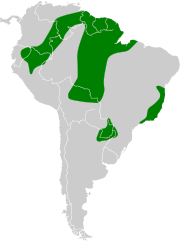Hylocharis
| Hylocharis | |
|---|---|

| |
| Gilded sapphire (Hylocharis chrysura) photographed in São Paulo, Brazil. | |
| Scientific classification | |
| Domain: | Eukaryota |
| Kingdom: | Animalia |
| Phylum: | Chordata |
| Class: | Aves |
| Clade: | Strisores |
| Order: | Apodiformes |
| Family: | Trochilidae |
| Tribe: | Trochilini |
| Genus: | Hylocharis Boie, F, 1831 |
| Type species | |
| Trochilus sapphirinus (rufous-throated sapphire) Gmelin, JF, 1788
| |
| Species | |
|
2, see text | |
Hylocharis is a genus of hummingbirds, in the family Trochilidae. It contains two species that are both found in South America.
Taxonomy
The genus Hylocharis was introduced in 1831 by the German naturalist Friedrich Boie.[1] The type species was designated by the English zoologist George Robert Gray in 1840 as the rufous-throated sapphire.[2][3] The genus name combines the Ancient Greek hulē meaning "woodland" or "forest" with kharis meaning "beauty".[4]
This genus formerly included additional species. A molecular phylogenetic study published in 2014 found that the genus Hylocharis was polyphyletic.[5] In the revised classification to create monophyletic genera, species were moved to Chrysuronia and Chlorestes.[6][7]
The genus now contains the following two species:[6]
| Common name | Scientific name and subspecies | Range | Size and ecology | IUCN status and estimated population |
|---|---|---|---|---|
| Rufous-throated sapphire | Hylocharis sapphirina (Gmelin, JF, 1788) |
Bolivia, Brazil, Colombia, Ecuador, the Guianas, Peru, Venezuela and possibly Argentina and Paraguay
|
Size: Habitat: Diet: |
LC
|
| Gilded sapphire | Hylocharis chrysura (Shaw, 1812) |
Argentina, Bolivia, Brazil, Paraguay, and Uruguay.
|
Size: Habitat: Diet: |
LC
|
References
- ^ Boie, Friedrich (1831). "Bemerkungen über Species und einige ornithologische Familien und Sippen". Isis von Oken (in German). Cols 538–548 [546].
- ^ Gray, George Robert (1840). A List of the Genera of Birds : with an Indication of the Typical Species of Each Genus. London: R. and J.E. Taylor. p. 14.
- ^ Peters, James Lee, ed. (1945). Check-List of Birds of the World. Vol. 5. Cambridge, Massachusetts: Harvard University Press. p. 52.
- ^ Jobling, James A. (2010). The Helm Dictionary of Scientific Bird Names. London: Christopher Helm. p. 197. ISBN 978-1-4081-2501-4.
- ^ McGuire, J.; Witt, C.; Remsen, J.V.; Corl, A.; Rabosky, D.; Altshuler, D.; Dudley, R. (2014). "Molecular phylogenetics and the diversification of hummingbirds". Current Biology. 24 (8): 910–916. doi:10.1016/j.cub.2014.03.016.
- ^ a b Gill, Frank; Donsker, David; Rasmussen, Pamela, eds. (January 2022). "Hummingbirds". IOC World Bird List Version 12.1. International Ornithologists' Union. Retrieved 2 August 2022.
- ^ Stiles, F.G.; Remsen, J.V. Jr.; Mcguire, J.A. (2017). "The generic classification of the Trochilini (Aves: Trochilidae): reconciling taxonomy with phylogeny". Zootaxa. 4353 (3): 401–424. doi:10.11646/zootaxa.4353.3.

